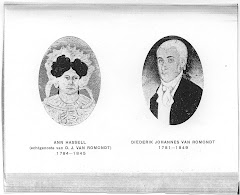Family Genealogy:
The Netherlands:
The genealogy of the van Romondt family started with Johan van Romunde
( 1455-1510). Herman van Romunde/Romondt was son of Johan van Romunde
and Liesbeth Lyze NN. Herman van Romunde married Grieta Rademaicker and in 1544
Grieta decided that her fief (Leengoed) "'t Holthuis of Lincksgoet" under Angerlo, leenroerig
aan den huize Keppel should be divided among her six children. The couple owned a
house in the "Langebisschopstraat" in Deventer, The Netherlands.
(http://www.landschapoverijssel.nl/terreinen/holthuis.htm)
The couple had six children:
Johan van Romunde (died in 1561)
Gerrit van Romunde (died between 1575-1581)
Henrick van Romunde (died < 29 Sept. 1609)
Christina van Romunde (died < 4 Feb 1605)
Elisabeth vn Romunde (died. < 4 Feb 1605)
Jenneken van Romunde (died <16 Sep 1561)
Sint Maarten
The van Romondt family of the West Indian Branch are all descendants of the
second son of Herman, Gerrit van Romunde whom son was Johan van Romunde.
Diederick Johannes van Romondt (1781-1849), forefather of the West Indian Branch
came to the island of Sint Maarten arrived in Sint Maarten in 1800 and married Ann Hassell.
The couple had eight children:
Johannes Willem
Diederick Christiaan
George Illidge
Susanna Elisabeth
Lumina Maria
Willem Hendrik
Charles Roelof
August Alexander
Diederick Johannes van Romondt was the first member of the van Romondt family
to set foot on SintMaarten and with this he established the van Romondt West
Indian Branch within the van Romondt family originating from the Netherlands.
Currently the van Romondt family consists of three branches: The Utrechtse Branch,
The Enkhuizer Branch and The West Indian Branch.
Throughout the years the family grew and has been one of the most prominent
families on the island of Sint Maarten with many historical facets which are all part of the
history of Sint Maarten.
New dimension in genealogy:
Please know that the Van Romondt West Indian Branch Research Project Research
has brought a new dimension in genealogy, whereas their is no distinction in the
descendants in the family tree. Looking back at the history of Sint Maarten between the
period 1800-1900 you can notice that the van Romondt family was one of the most powerful
families on the island as they owned majority of the properties and estates and were very
active in government. Slavery is also a part of the history and during this period that
Diederick Johannes van Romondt was governor of Sint Maarten(1820-1840). After his
period his 1st, son Johannes Willem van Romondt became governor of Sint Maarten.
Descendants in Sint Maarten:
As the van Romondt family grew on the island several van Romondt men had other children
before, during and or after their marriages and whom for whatever reason have not
acknowledged these children. These children carried their mother's name and were part of
the population of Sint Maarten. Some of them grew up with their van Romondt father while
others made a living with their mother. Due this matter up to this day in Sint Maarten there is
not one living person who carries the last name van Romondt on the island of Sint Maarten.
Many families still live in Sint Maarten while others left the island and living worldwide.
Van Romondt's worldwide:
Many van Romondt's branches and their families left to the U.S.A., Canada, Aruba, Curacao,
Bonaire, Suriname, The Netherlands, Belgium, Martinique, Guadeloupe, Indonesia and many
other places worldwide.
Finding the descendants:
Due to the many historical and oral history & facts and other information we were able to
find majority descendants all over the world and this has enable everyone to connect to each
other and create the Van Romondt West Indian Branch Research Project.
Dedication:
This research is dedicated to all descendants of the van Romondt family of the West
Indian Branch especially to all those who have the memories and those who never knew or
understood their true family heritage and with the help of this research have been able
to find their true family roots.
Sunday, January 22, 2012
Subscribe to:
Post Comments (Atom)



No comments:
Post a Comment